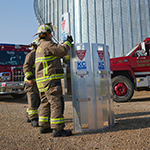Proper grain management techniques
Maintaining grain quality in storage can prevent grain spoilage and eliminate the leading cause for bin entry.
Grain bin safety starts with proper grain management.
Every year, we’re reminded how dangerous grain storage can be. According to Penn State Extension, approximately 36 grain bin entrapments occur annually with over half of engulfment incidents resulting in a fatality. Grain bin accidents can tragically impact individuals, families and entire communities.
The behavior and weight of grain makes it extremely difficult for a worker to get out of the grain without assistance. Tragically, incidents in grain bins can result in multiple fatalities when others attempt to rescue and become engulfed as well.
Learn how you can nominate your local fire department to win grain bin rescue training and a rescue tube.
The only true way to help reduce the risk of grain entrapment is to strongly discourage people from entering a bin, unless it’s absolutely necessary. That means developing a “zero-entry mentality” with a focus on key areas to help keep you and others out of grain bins and harm’s way. One such area is grain management.
Grain bin safety starts with maintaining grain quality in storage, which means learning and practicing better stored-grain quality management, while closely monitoring grain condition. Most grain entrapment incidents develop around poorly flowing grain resulting from some type of grain spoilage issue. So if you can prevent spoilage, you may be able to eliminate the leading cause of bin entry.
For optimum success in storing and handling grain, consider the following:
Clean grain. Prior to placing grain into storage, it’s important to remove chaff, weed seeds, bees wings and broken and immature kernels. Clean grain improves future aeration and helps reduce the potential for mold growth, heating and quality loss. Failure to properly clean grain can lead to spoilage, flow stoppage and an increased probability of dangerous bin entry.
Dry grain. To help ensure grain quality, dry grain to the recommended storage moisture (percent wet basis for clean, aerated grain crops) before placing it into the bin. When drying grain, you should keep kernel temperature under 110o F to preserve germination and under 140o F to preserve milling quality. And to improve drying efficiency and energy conservation, we recommend you clean grain prior to drying and avoid drying in below freezing temperatures.
Handle gently. Damaged, cracked or broken kernels are more prone to deterioration and microbiological action than good, quality grain. You can help minimize cracked and broken kernels by handling grain gently. This means minimizing drop heights, using decelerators and cushion boxes, limiting drying air temperature and reducing retention time in the heat sections of grain dryers. Colder grain temperatures can also increase kernel cracking and breakage during elevation and grain movement.
It’s also a good idea to always core bins to remove fines, especially if mold or mold development is a possibility. Coring is a simple method of leveling a peaked bin and removing part of the center grain column of trash and foreign material. Because a level grain surface is important to controlling grain temperature and insect activity, be sure to re-level the grain after any coring has been completed.
Follow recommended moisture content and temperature levels. Grains have a shelf life just like any food product. Refer to the storage management table to get storage life for corn and soybeans at varying moisture levels and temperatures. Storing grain with higher than recommended moisture content should be avoided at all times. Grain should be stored in aerated structures and at the lowest possible moisture level for the storage time desired. The longer you plan to store your grain, the drier the grain should be at the time of initial storage. Look for marketing opportunities in lieu of storing high-moisture grain.
Aerate grain. Upon storing grain, reduce grain temperatures to 50o F or less. For optimal winter storage, cool grain to 30 - 35o F or less and maintain low grain temperatures for as long as possible. Move a cooling front completely through and out of the grain mass to minimize condensation and crusting. Seal off and shut down fans to prevent early warm up of grain. During wet or humid weather, aerating is not recommended. Allowable storage time decreases rapidly as grain temperature or moisture content increases. Check with local grain storage experts or your local extension service for additional recommendations related to individual field or harvest time grain concerns.
Check often. Binned grain should be checked once every two weeks during the winter months. Check bins once a week in the fall and when temperatures begin to rise in late winter or early spring. Run aeration fans, check for unusual odors and cover aeration-fan inlets when not in use. Check for roof leaks as part of your regular inspection and repair all bin damage as soon as possible. Be alert for condensation on the inside of the roof. When using bin-temperature cables, closely monitor grain temperature to determine when to operate aeration fans. Often these cables are too far away from the warm spot to accurately record an increase in temperature. If you identify a temperature problem, core the bin immediately to determine the extent of the problem. This should provide insight into the necessary actions, such as providing additional aeration or removing additional grain.
Take immediate action if problems arise. Insect activity, excess fines, rising grain temperature, higher moisture levels and excess molds can negatively impact grain quality and should be handled promptly.
Remember your health. Breathing in grain dust and molds can cause severe respiratory problems. Always use proper personal protective equipment when cleaning out bins or handling dusty or moldy grain. And never enter a bin while equipment is running. If you must go in, follow lock out/tag out and confined-space entry procedures. The life you save may be your own.

 >
>

 >
>
 >
>